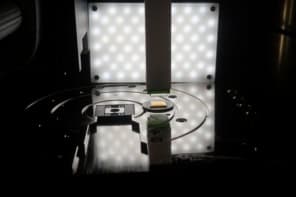
Physicists in the US and China have boosted the performance of a common thermoelectric material by modifying its electronic band structure. The improvement was made by carefully adjusting the relative abundances of tellurium and selenium in a lead alloy. The result is a material with an all-time-high thermoelectric figure of merit of 1.8 – a result that could lead to new types of thermoelectric devices that can convert waste heat into useful electricity.
A thermoelectric generator converts heat directly into electricity and comprises two thermoelectric semiconductors – one n-type and the other p-type. Devices based on lead telluride (PbTe) have been used to generate electricity since the 1960s. These have been used on space missions – where radioisotopes provide the heat – and in commercial systems here on Earth where the heat is generated by burning gas or another fuel. In principle, thermoelectric systems could also capture waste heat from anything from solar panels to car exhausts to nuclear power stations, thereby improving the energy efficiency of these processes. But before this is can happen, scientists must boost the performance of thermoelectric materials.
To be of any use, a thermoelectric material must be good at conducting electricity but poor at conducting heat. It must also have a large thermopower, which is the ratio of the voltage to temperature difference across a material. These requirements are expressed in the thermoelectric figure of merit ZT, which should be greater than about 1.5.
Promising materials
PbTe-based materials have long been seen as good candidates because they have relatively high figures of merit, long lifetimes and can operate at the high temperatures that occur in car exhausts and similar environments. However, the figures of merit for these materials have remained stubbornly below one.
In this latest work, Jeffrey Snyder and colleagues at the California Institute of Technology and the Chinese Academy of Sciences have modified the electronic band structure of PbTe-based materials to achieve a figure of merit of 1.8 at 850 K – a value that they describe as “extraordinary”.
The team achieved this by taking advantage of the fact that doping PbTe with selenium causes the convergence of many “degenerate valleys” within the electronic band structure of the material. According to Snyder, increasing the number of degenerate valleys increases the speed at which the charge-carrying holes can pass through the material. The result is a boost in the electrical conductivity and therefore the thermoelectric figure of merit.
Many valleys
The commercial thermoelectric material (Bi,Sb)2Te3, for example, is known to have a valley degeneracy of six. However, by substituting about 20% of the tellurium atoms in PbTe with selenium, Snyder’s team achieved a valley degeneracy of 16. The result is a figure of merit of 1.8 for this p-type material.
Higher ZT values have been reported before, but Snyder told physicsworld.com that he believes that this is the highest ZT to be reproduced in independent laboratories. “While I would not be surprised if I am informed of other examples I may have missed, this is the highest ZT discussed in the thermoelectric community in the past five years,” he says.
Akram Boukai of the University of Michigan described the work as “compelling”, since, he suggests, it is the first time someone has succeeded in utilizing band degeneracy for simultaneously enhancing the electrical conductivity while not significantly affecting the thermopower. “I believe this may lead to practical devices since this was done using a bulk process amenable to large-scale manufacturing,” he says. However, he points out that a suitable n-type material must also be developed.
To make a practical thermoelectric generator – with a high overall figure of merit – both p- and n-type materials must be found with high average ZT values over a wide temperature range of about 50–500 °C. The ZT of samples made by Snyder and colleagues drops off rapidly with temperature, and the team is now working on improving this by further engineering the electron energy levels. Snyder says that the team has also made progress in creating a promising n-type material.
The research is reported in Nature 473 66.



